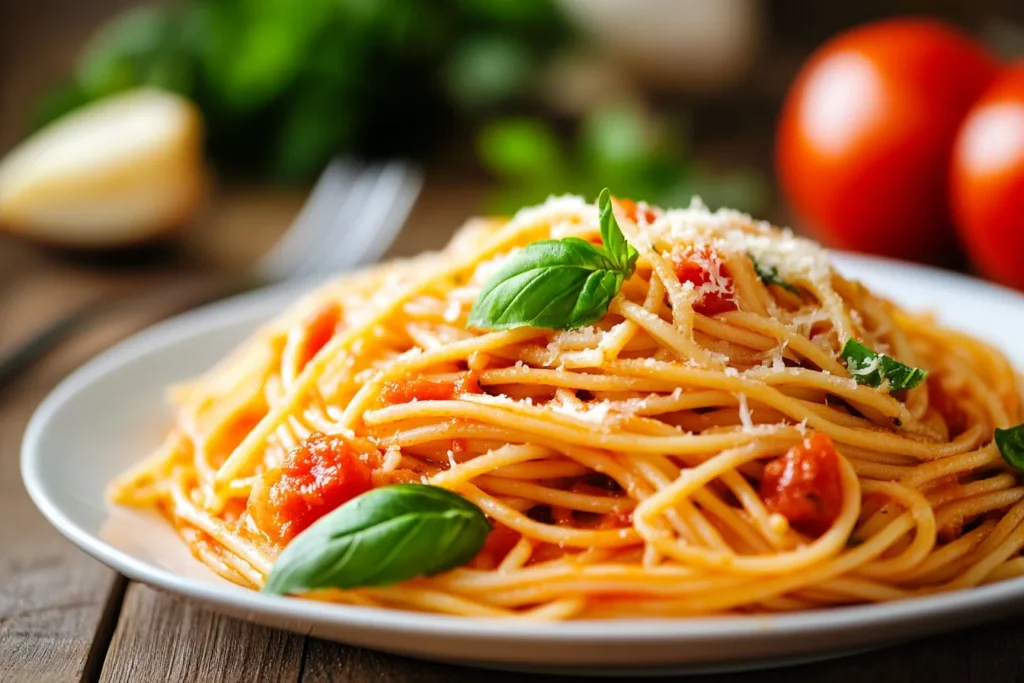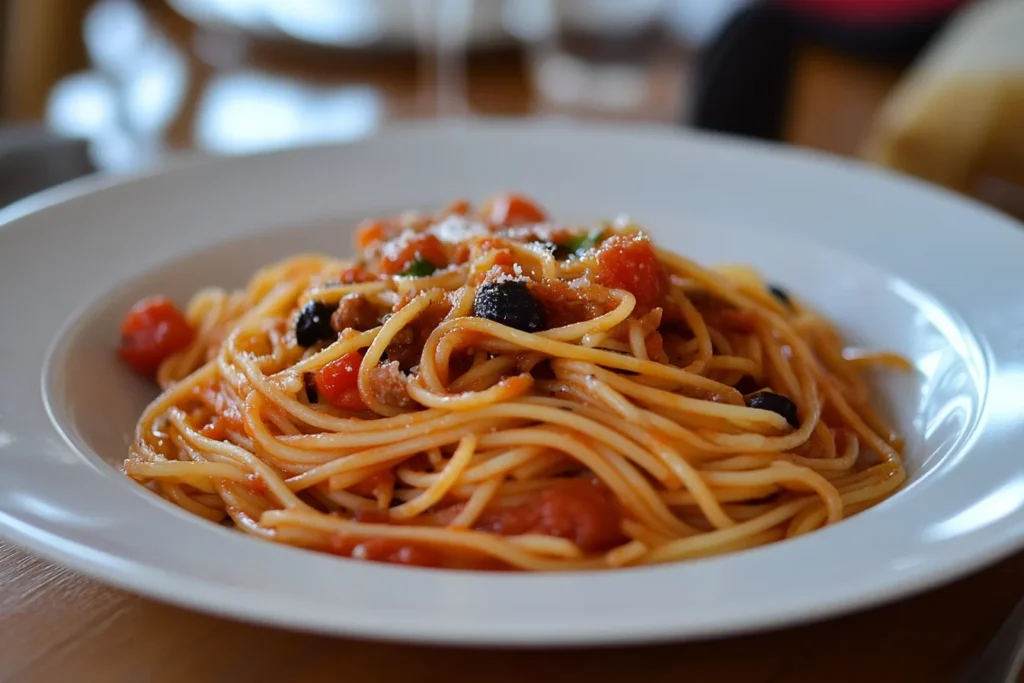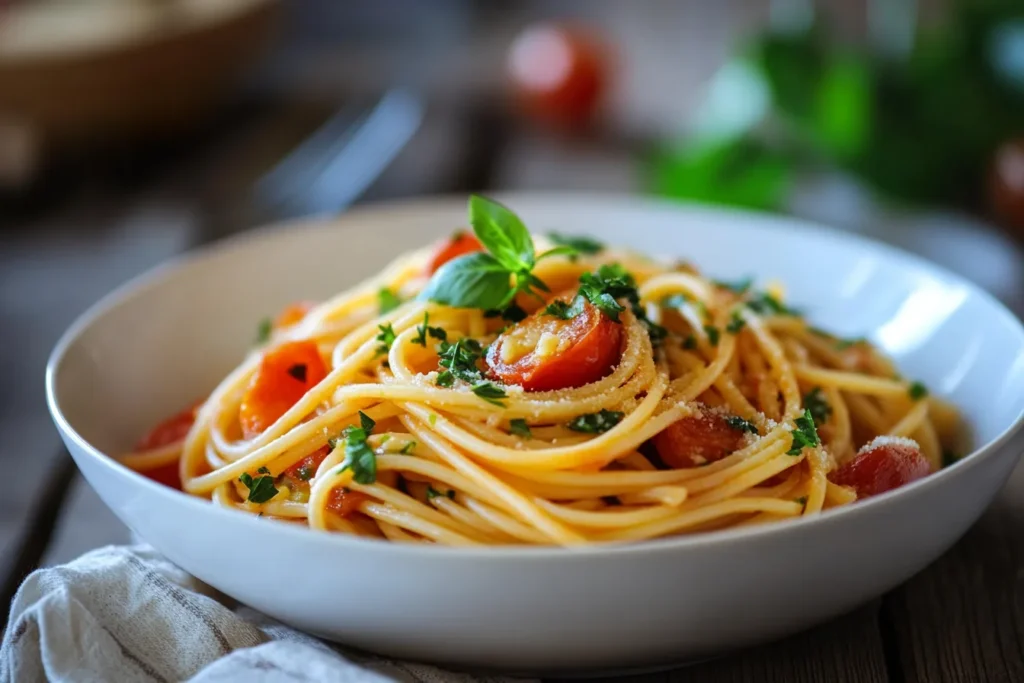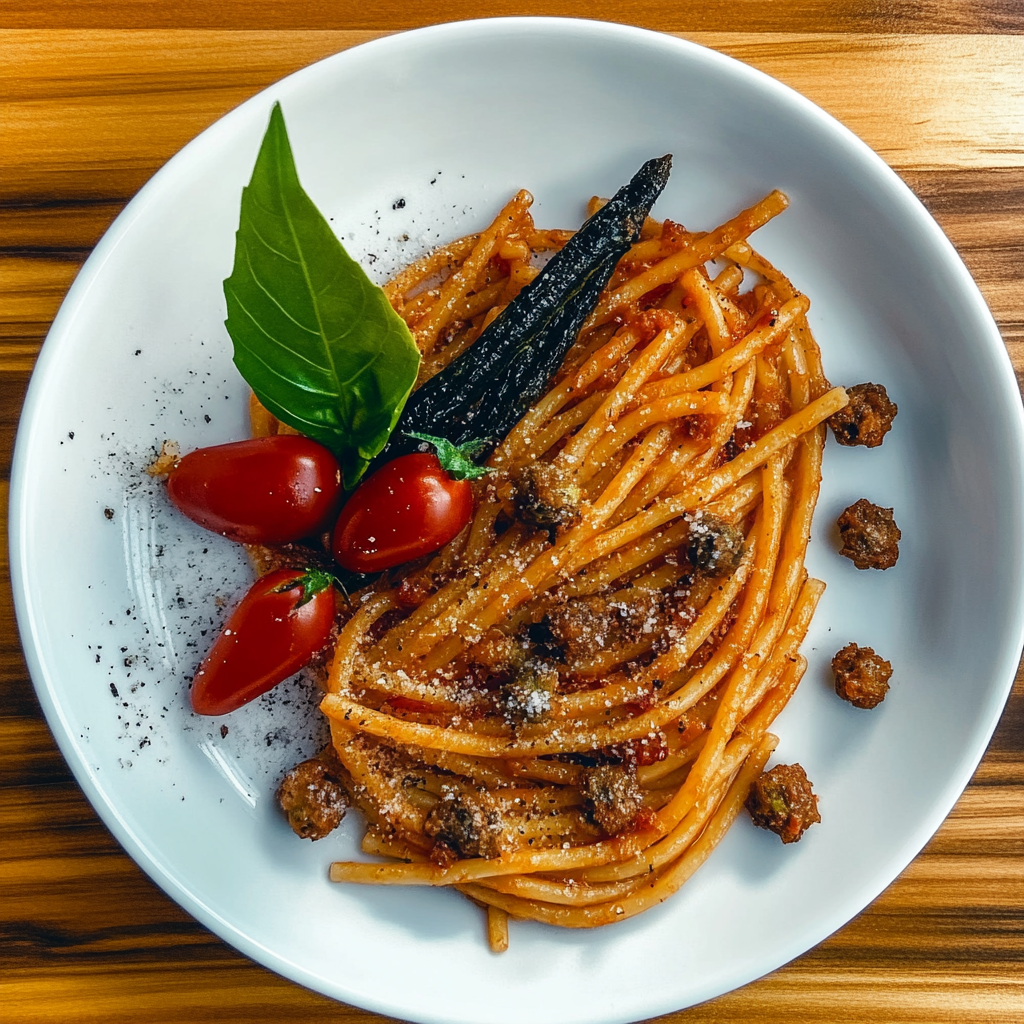Spaghetti is a timeless dish loved across the globe. But when vegetables enter the picture, this simple pasta transforms into a vibrant, nutrient-packed, and flavorful meal. From enhancing the sauce’s depth to adding unique textures, vegetables are a must-have for any vegetarian spaghetti recipe.
In this guide, we’ll explore the classic vegetables that elevate spaghetti dishes, focusing on their nutritional benefits, versatility, and flavor contributions. Let’s dive in!
Why Vegetables Elevate Spaghetti Dishes
Adding vegetables to spaghetti offers countless benefits beyond taste alone. Here’s why:
- Nutritional Boost: Vegetables pack essential vitamins, minerals, and antioxidants into your pasta dish. For instance, spinach is a nutrient powerhouse loaded with iron and fiber.
- Flavor Enhancement: Fresh or roasted vegetables add layers of sweetness, earthiness, or even umami flavors that elevate simple spaghetti dishes.
- Texture Variety: From crunchy bell peppers to soft mushrooms, vegetables provide contrast and depth to each bite, keeping your meal exciting.
By incorporating vegetables, you transform your pasta into a wholesome and satisfying meal, perfect for busy weekdays or special dinners.
Classic Vegetables for Vegetarian Spaghetti
If you’re looking to stick with timeless options that never fail, these vegetables are perfect for any spaghetti recipe.
Tomatoes – The Heart of Spaghetti Sauce
Tomatoes are the foundation of most spaghetti dishes, serving as the base for marinara, arrabbiata, or even creamy tomato sauces. Whether fresh, roasted, or canned, tomatoes bring acidity, natural sweetness, and a vibrant red color to your dish.
- Fresh Tomatoes: Use ripe Roma or vine tomatoes for a light, garden-fresh sauce.
- Roasted Tomatoes: Slow-roasting tomatoes deepens their sweetness and adds a caramelized flavor.
- Canned Tomatoes: Opt for crushed or whole peeled tomatoes for convenience. Brands like San Marzano are highly recommended for their rich, smooth taste.
Pro Tip: Blend roasted tomatoes with garlic and olive oil for a quick and flavorful sauce.

Onions and Garlic – The Flavor Base
Onions and garlic are the unsung heroes of most spaghetti recipes. They provide the initial flavor foundation, creating depth and warmth in every bite.
- Onions: Sautéed onions become sweet and tender. You can caramelize them for added richness or dice them for a subtle background flavor.
- Garlic: Freshly minced garlic adds a punch of aromatic sharpness. For a milder flavor, roast garlic until it’s creamy and golden.
Together, onions and garlic ensure your sauce has an unmistakable savory essence that complements other vegetables.
Bell Peppers – Adding Sweetness and Crunch
Bell peppers are versatile vegetables that bring sweetness, color, and a mild crunch to vegetarian spaghetti. You can choose between:
- Red Peppers: The sweetest and most vibrant option. Perfect for roasting or sautéing.
- Yellow and Orange Peppers: Mildly sweet and visually appealing.
- Green Peppers: Slightly bitter but adds a refreshing contrast.
Best Use: Dice bell peppers and toss them into the sauce, or roast them for a slightly charred flavor that complements spicy pasta dishes.
Mushrooms – Meaty and Savory Texture
Mushrooms are a game-changer for vegetarian spaghetti because they mimic a meaty texture while adding an earthy, umami flavor. Popular options include:
- Portobello: Great for grilling and slicing. Perfect for hearty sauces.
- Button Mushrooms: The classic choice for light sautéing.
- Shiitake: A strong, woody flavor ideal for Asian-inspired spaghetti.
- Cremini (Baby Bella): A middle ground between button mushrooms and Portobello in taste and texture.
Cooking Tip: Sauté mushrooms in olive oil until golden to release their moisture and intensify their flavor.
Zucchini – Light and Versatile Addition
Zucchini is an excellent addition to vegetarian spaghetti because it’s light, versatile, and absorbs surrounding flavors. You can:
- Dice or cube zucchini for sautéing.
- Spiralize it as a low-carb pasta alternative.
- Roast it for a slightly crispy exterior and tender interior.
Its mild flavor works well with garlicky sauces or creamy pesto spaghetti.
Spinach – Nutrient-Dense Green
Spinach is a superfood that seamlessly blends into spaghetti dishes, providing nutrients like iron, calcium, and vitamins A and C. You can use:
- Fresh Spinach: Add it to the sauce right before serving. It wilts quickly, preserving its color and texture.
- Frozen Spinach: A convenient option, especially for creamy sauces. Thaw and squeeze out excess water before use.
Spinach pairs beautifully with garlic, lemon zest, and cream-based sauces. It adds a vibrant green pop that makes your pasta visually appealing.
Carrots – Sweetness and Color
Carrots bring a subtle sweetness and bright color to vegetarian spaghetti dishes. They work well in:
- Grated Form: Adds a natural sweetness to tomato-based sauces.
- Diced or Sliced: Provides a slight crunch and earthy flavor.
- Cooked in Sauces: Softens their texture while blending beautifully with other vegetables.
Carrots are especially useful for balancing the acidity of tomatoes in marinara or bolognese-style sauces.
Conclusion: Elevate Your Vegetarian Spaghetti with Classic Vegetables
The combination of tomatoes, onions, garlic, bell peppers, mushrooms, zucchini, spinach, and carrots creates a harmonious balance of flavors, textures, and nutrients in vegetarian spaghetti dishes. Each vegetable offers a unique quality, whether it’s the meaty richness of mushrooms or the sweetness of carrots. By incorporating these timeless ingredients, you’ll transform your spaghetti into a wholesome, flavorful, and satisfying meal every time.
Unique Vegetables to Spice Up Your Spaghetti
While classic vegetables like tomatoes, onions, and mushrooms create a strong foundation, unique vegetables add an extra layer of creativity and flavor. By experimenting with these options, you can make your vegetarian spaghetti truly stand out.
Eggplant – Creamy and Rich Flavor
Eggplant is a Mediterranean staple that brings a unique creamy texture and slightly smoky flavor to spaghetti dishes. When cooked properly, eggplant becomes tender and absorbs the flavors of sauces and seasonings beautifully.
- Grilled Eggplant: Brush slices with olive oil, sprinkle salt, and grill them for a rich, smoky taste.
- Roasted Eggplant: Dice and roast eggplant to bring out its natural sweetness.
- Sauce Base: Combine roasted eggplant with tomatoes, garlic, and basil for a hearty and creamy sauce.
Pro Tip: Salt sliced eggplant and let it sit for 15 minutes before cooking to remove any bitterness.
Broccoli – Crunchy and Nutritious
Broccoli is a nutrient-dense vegetable packed with fiber, vitamin C, and antioxidants. It adds a wonderful crunch and earthy flavor to vegetarian spaghetti dishes.
- Steamed Broccoli: Lightly steam florets and toss them into your spaghetti just before serving.
- Pan-Fried Broccoli: Sauté broccoli in olive oil with garlic and chili flakes for a slightly crispy, flavorful addition.
- Roasted Broccoli: Roasting broccoli intensifies its flavor and adds a crispy texture.
Broccoli pairs perfectly with spicy arrabbiata sauces or creamy Alfredo-style pasta.
Kale – A Hearty Leafy Green
Kale is a superfood that adds a hearty texture and a slightly bitter taste to spaghetti dishes. When sautéed or roasted, it becomes tender and flavorful.
- Chopped and Sautéed: Add kale to garlic and olive oil, then toss it into your pasta.
- Roasted Kale: Bake kale leaves until crispy for a crunchy topping.
- Blended into Sauces: Combine kale with basil, nuts, and olive oil for a nutrient-rich pesto sauce.
Kale works well with garlic-based spaghetti or dishes featuring lemon and chili for added brightness.
Artichoke Hearts – A Mediterranean Twist
Artichoke hearts bring a tender, slightly tangy flavor to spaghetti, making them a perfect addition to Mediterranean-inspired dishes. Not only are they versatile, but they’re also incredibly easy to incorporate into a variety of recipes.
To add a burst of zesty flavor, simply toss in marinated artichokes straight from the jar. If you’re looking for something richer, try roasting artichoke hearts with olive oil; this method deepens their natural taste and adds a subtle smokiness. Alternatively, chopping them into smaller pieces and stirring them into tomato or cream sauces provides both texture and a satisfying tang.
For the ultimate Mediterranean spaghetti, pair artichoke hearts with spinach and sun-dried tomatoes. The combination offers a perfect balance of flavors that is both refreshing and hearty.

Asparagus – Earthy and Tender
Asparagus adds a delicate, earthy flavor and a slightly tender-crisp texture to vegetarian spaghetti. It’s particularly perfect for springtime dishes.
- Steamed Asparagus: Preserve its bright green color and tenderness.
- Pan-Sautéed Asparagus: Cook asparagus in olive oil with garlic and lemon zest for a fresh, zesty addition.
- Chopped in Pasta: Slice into smaller pieces and toss directly into spaghetti.
Asparagus pairs beautifully with lemony pasta sauces or pesto for a fresh and light meal.
Peas – Adding Sweetness and Brightness
Green peas bring a natural sweetness and vibrant color to spaghetti dishes. They’re perfect for balancing savory flavors.
- Fresh Peas: Best for spring recipes; add them during the final minutes of cooking.
- Frozen Peas: Quick and convenient for year-round use.
Combine peas with mint, cream, or Parmesan for a refreshing twist on vegetarian spaghetti.
Sweet Corn – Pop of Sweet and Crunch
Sweet corn adds a delightful touch of sweetness and a satisfying crunch to spaghetti, offering a playful textural contrast. During the summer months, using fresh kernels straight off the cob brings unmatched freshness and vibrant flavor. However, if you’re short on time, frozen corn serves as a convenient alternative that works beautifully for year-round meals.
To take the flavor up a notch, consider sautéing the corn with butter, garlic, and a pinch of chili flakes. This quick preparation method transforms simple corn into a savory, slightly spicy delight that complements a variety of pasta dishes.
Whether you’re making vegetable primavera spaghetti or preparing a rich, creamy sauce, sweet corn effortlessly blends in, balancing flavors and adding visual appeal. Its versatility makes it a go-to choice for creating a well-rounded, flavorful vegetarian spaghetti.
Butternut Squash – Creamy and Sweet
Butternut squash is a versatile ingredient that adds a rich, creamy texture and natural sweetness to vegetarian spaghetti, making it ideal for fall and winter recipes. Its vibrant orange hue and subtle, nutty flavor bring both visual appeal and depth to your dish.
For a caramelized and slightly sweet flavor, dice the squash into cubes and roast it with olive oil, salt, and pepper. Alternatively, you can blend roasted butternut squash with cream or vegetable broth to create a luscious, velvety puree that works beautifully as a sauce base. If you prefer a heartier bite, simply add cubed squash to tomato-based sauces, where it softens perfectly while absorbing the surrounding flavors.
To elevate the dish even further, pair butternut squash with sage, nutmeg, and a sprinkle of Parmesan. This classic combination creates a comforting, warm spaghetti dish that’s perfect for cozy evenings and special meals alike.rmesan, creating a comforting and warm spaghetti dish.
Cauliflower – Low-Carb Texture Boost
Cauliflower is a low-carb powerhouse that adds bulk and texture to vegetarian spaghetti without overwhelming the dish’s core flavors. Its mild, neutral taste makes it the perfect canvas for bold sauces and seasonings.
- For a nutty and crispy element, try roasting cauliflower with olive oil and spices. The caramelization enhances its natural flavor and adds a slight crunch.
- If you’re looking for a pasta alternative, opt for riced cauliflower. It works as a light, grain-free base that soaks up any sauce beautifully.
- For a softer, caramelized touch, sautéed cauliflower is the way to go. Cook it with garlic, olive oil, and a hint of lemon for a subtle, savory flavor.
Cauliflower pairs particularly well with garlicky olive oil sauces or spicy arrabbiata spaghetti, providing a satisfying textural contrast and boosting the dish’s heartiness.
Kaleidoscope of Vegetables – Mixing for Maximum Flavor
Why stop at just one or two vegetables when you can enjoy a kaleidoscope of flavors and textures in your spaghetti? Combining a variety of vegetables not only makes your dish visually stunning but also adds layers of taste and nutrition.
Here are some winning combinations to inspire your next creation:
- Tomatoes + Bell Peppers + Onions: A sweet, tangy classic that’s perfect for simple marinara sauces.
- Broccoli + Zucchini + Mushrooms: An earthy, meaty, and vibrant mix that provides a hearty bite.
- Eggplant + Spinach + Artichoke Hearts: A creamy, Mediterranean-inspired trio with rich textures and bold flavors.
- Asparagus + Peas + Sweet Corn: A fresh, springtime mix that balances sweetness with tender greens.
By mixing vegetables, you can achieve the perfect balance of flavors, textures, and colors, transforming your spaghetti into a satisfying, nutrient-dense masterpiece. Whether you prefer roasted, sautéed, or steamed veggies, this approach ensures every bite is bursting with variety and freshness.

Conclusion: Unique Vegetables for Standout Spaghetti Dishes
By incorporating unique vegetables like eggplant, asparagus, kale, and butternut squash, you can transform traditional spaghetti into a creative and unforgettable dish. These vegetables add flavor, texture, and nutrients while letting you explore different culinary styles, from Mediterranean to hearty comfort meals.
Whether you’re roasting eggplant for creaminess or adding peas for sweetness, these unique vegetables will elevate your vegetarian spaghetti to a whole new level.
Tips for Preparing Vegetables for Spaghetti
To maximize flavor, texture, and nutrition in your vegetarian spaghetti, preparing your vegetables the right way is essential. Below are tried-and-true techniques that bring out the best in your ingredients.
Roasting Vegetables for Enhanced Flavor
Roasting is one of the best techniques to bring out a vegetable’s natural sweetness while adding depth and complexity to its flavor. The high heat caramelizes the sugars, giving the vegetables a slightly smoky and rich taste that elevates any spaghetti dish.
Best Vegetables to Roast: Tomatoes, bell peppers, zucchini, eggplant, broccoli, butternut squash, and cauliflower are all perfect candidates for roasting.
How to Roast:
- Preheat your oven to 400°F (200°C).
- Toss your vegetables with olive oil, salt, pepper, and optional seasonings like thyme, rosemary, or smoked paprika.
- Spread the vegetables evenly on a baking sheet, ensuring they aren’t overcrowded.
- Roast for 20-30 minutes, turning halfway through for even caramelization.
Pro Tip: Use roasted vegetables as a flavorful topping for your spaghetti or blend them into a rich, velvety sauce. Roasted tomatoes, bell peppers, and garlic, for example, can be pureed into a smoky marinara that pairs beautifully with other vegetables.
By roasting, you transform simple vegetables into flavor-packed, texturally appealing additions that will take your vegetarian spaghetti to the next level.ables as a topping for spaghetti or blend them into a creamy sauce.
Sautéing Vegetables in Olive Oil
Sautéing vegetables in olive oil is quick, easy, and ensures they retain their vibrant color and slight crunch. This method works especially well for garlic, onions, spinach, and bell peppers.
- Best Practices for Sautéing:
- Heat a generous amount of olive oil over medium heat.
- Add aromatics first, like garlic and onions, for a flavor base.
- Add hard vegetables like carrots or broccoli, cooking until tender.
- Toss in soft greens like spinach at the end to wilt quickly.
Sautéed vegetables pair perfectly with garlic-based spaghetti or classic tomato sauces.
Blanching Greens for Retaining Bright Color
Blanching is ideal for tender leafy greens like spinach, kale, or asparagus tips. This quick cooking method preserves their vibrant color and delicate texture.
- Steps to Blanch Vegetables:
- Bring a pot of salted water to a boil.
- Add the greens and boil for 1-2 minutes.
- Immediately transfer to an ice bath to stop the cooking process.
- Drain well and pat dry before adding to your spaghetti.
Pro Tip: Blanched spinach works beautifully in pesto or creamy sauces.
Spiralizing Vegetables as Pasta Alternatives
For a low-carb, gluten-free option, spiralized vegetables serve as a delicious alternative to traditional spaghetti noodles.
- Best Vegetables to Spiralize: Zucchini, carrots, sweet potatoes, and butternut squash.
- How to Use:
- Spiralize vegetables using a spiralizer or vegetable peeler.
- Lightly sauté spiralized veggies in olive oil or serve raw with your sauce.
Spiralized zucchini, also called zoodles, pairs perfectly with pesto, marinara, or garlic-infused olive oil.
Vegan Spaghetti Sauce with Mixed Vegetables
One of the best ways to incorporate vegetables is by making a hearty, vegan-friendly spaghetti sauce. This recipe combines classic and unique vegetables for maximum flavor.
Ingredients:
- 2 tablespoons olive oil
- 1 onion, finely chopped
- 4 garlic cloves, minced
- 1 red bell pepper, diced
- 1 zucchini, diced
- 1 cup mushrooms (button or cremini), sliced
- 1 eggplant, cubed
- 2 cups crushed tomatoes
- 1 tablespoon tomato paste
- 1 teaspoon dried basil
- 1 teaspoon oregano
- 1/2 teaspoon chili flakes (optional)
- Salt and pepper to taste
- Fresh basil for garnish
Instructions:
- Sauté Aromatics: Heat olive oil in a large pan. Sauté the chopped onions for 3-4 minutes until soft. Add garlic and cook for 1 minute.
- Add Vegetables: Add bell pepper, zucchini, mushrooms, and eggplant. Sauté until they soften and release their juices (about 8-10 minutes).
- Add Tomatoes: Stir in crushed tomatoes, tomato paste, dried basil, oregano, and chili flakes. Simmer on low heat for 20 minutes, stirring occasionally.
- Season and Serve: Season with salt and pepper. Toss with cooked spaghetti and garnish with fresh basil.
This sauce is rich, hearty, and packed with flavorful vegetables. Serve with a sprinkle of vegan Parmesan for a finishing touch.
Recipe Ideas for Vegetarian Spaghetti
If you’re searching for ways to bring variety and excitement to your spaghetti, these delicious vegetarian recipes are sure to inspire you. Each one highlights the versatility of vegetables, creating meals that are both satisfying and nutrient-rich.
Pesto Spaghetti with Spinach and Zucchini
For a refreshing twist, prepare a nutrient-rich pesto using fresh basil, spinach, garlic, pine nuts, olive oil, and Parmesan cheese. Blend everything until smooth, creating a vibrant green sauce that’s both aromatic and healthy.
To elevate the dish further, toss the pesto with spiralized zucchini and cooked spaghetti. The combination of fresh greens and light pasta makes this recipe perfect for summer meals or quick weekday dinners.
Creamy Tomato Sauce with Mushrooms and Eggplant
If you’re in the mood for something comforting and hearty, this creamy tomato-based spaghetti is ideal. Start by sautéing mushrooms until golden, and roast cubes of eggplant for added texture and depth.
For the sauce, blend tomatoes with cashew cream or heavy cream to achieve a luscious, velvety base. Mix everything together with the spaghetti, allowing the flavors to meld. This dish is rich, filling, and perfect for cozy evenings.
Vegetable Primavera Spaghetti
For a colorful, healthy dish, try vegetable primavera spaghetti. Begin by sautéing a mix of broccoli, bell peppers, zucchini, and carrots in olive oil with garlic. Be sure to keep the vegetables slightly crisp to retain their texture and nutrients.
Once cooked, toss the sautéed veggies with spaghetti and finish with a sprinkle of Parmesan cheese for added richness. This recipe offers a beautiful balance of flavors and vibrant colors, making it perfect for showcasing fresh, seasonal produce.
Spicy Arrabbiata with Bell Peppers and Broccoli
For those who love a fiery kick, this spicy arrabbiata is a must-try. Begin by roasting bell peppers to enhance their natural sweetness and steaming broccoli until tender.
Combine these vegetables with a spicy tomato sauce made from crushed tomatoes, garlic, chili flakes, and olive oil. Toss everything with spaghetti, and garnish with fresh herbs like parsley or basil. This bold, flavorful dish delivers the perfect balance of sweetness and spice.
By exploring these recipes, you can enjoy a variety of flavors, textures, and nutritional benefits in your vegetarian spaghetti dishes. Whether you’re in the mood for fresh pesto, creamy tomato sauces, or a fiery arrabbiata, there’s something here for every palate and occasion.
Final Thoughts on Choosing Vegetables for Spaghetti
Creating the perfect vegetarian spaghetti is all about balancing flavors, textures, and nutrition. Classic vegetables like tomatoes, mushrooms, and spinach provide a solid foundation, while unique options like eggplant, butternut squash, and artichoke hearts add creativity and variety.
By roasting, sautéing, or spiralizing vegetables, you can make your dish exciting and satisfying every time. Whether you prefer a simple tomato sauce or a creamy, hearty mix, vegetables elevate your spaghetti to a nutritious and flavor-packed masterpiece.
More FAQs
Here are some frequently asked questions to help you make the best vegetarian spaghetti:
- What’s the best vegetable for spaghetti sauce?
Tomatoes are the classic choice, but mushrooms, bell peppers, and zucchini add depth. - Can I use frozen vegetables for spaghetti?
Yes! Frozen spinach, peas, and broccoli are great time-saving options. - How do I make spaghetti gluten-free?
Use gluten-free pasta or spiralized vegetables like zucchini or sweet potato. - What vegetables pair well with pesto spaghetti?
Spinach, zucchini, asparagus, and peas complement pesto beautifully. - How do I add a smoky flavor to my spaghetti?
Roast vegetables like eggplant, tomatoes, or bell peppers. Smoked paprika also works well. - How do I prevent vegetables from becoming mushy?
Avoid overcooking; sauté or roast vegetables for better texture. - Can I add roasted vegetables to spaghetti?
Absolutely! Roasted vegetables add a caramelized, smoky flavor. - What’s a good creamy vegan spaghetti sauce?
Blend roasted butternut squash or cashews with vegetable broth and garlic for creaminess. - How can I make spaghetti more protein-packed?
Add legumes like lentils, chickpeas, or edamame to your spaghetti. - What’s the best way to add greens to spaghetti?
Sauté greens like spinach or kale in olive oil and garlic, then toss into your pasta.
Related Article :How to Make Dairy-Free and Vegan Spaghetti ?

